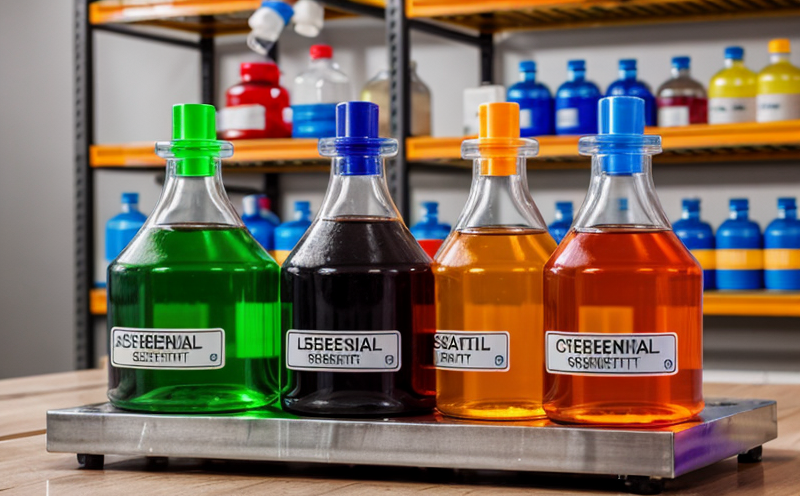Endocrine Disruption Testing in Consumer Goods
The testing of endocrine disrupting chemicals (EDCs) in consumer goods is a critical component of ensuring product safety and compliance with international standards. EDCs can interfere with the body’s hormone systems, potentially leading to adverse health effects such as developmental disorders, reproductive issues, and other systemic problems. This service focuses on identifying EDCs present in various consumer products like textiles, cosmetics, and electronic devices.
Our laboratory employs a comprehensive approach using advanced analytical techniques including liquid chromatography-tandem mass spectrometry (LC-MS/MS), gas chromatography-mass spectrometry (GC-MS), and Fourier transform infrared spectroscopy (FTIR). These methods help us detect trace amounts of suspected EDCs, ensuring that the products meet stringent safety standards.
The testing process begins with detailed specimen preparation. Samples are extracted using appropriate solvents based on the product type, followed by purification steps to isolate the potential EDCs for analysis. Once prepared, samples undergo rigorous analysis where we measure concentrations of known endocrine disruptors against established thresholds set forth in international standards such as ISO 18046:2015 and ASTM F2370-19.
It is essential to understand the implications of EDCs not only for public health but also from an environmental perspective. By identifying these compounds early, manufacturers can reformulate their products to avoid harmful substances, thereby reducing potential risks both during use and after disposal. This proactive approach supports sustainable practices that align with global initiatives aimed at minimizing chemical pollution.
Our findings play a crucial role in maintaining consumer trust by providing transparent information about the safety profile of each product. Additionally, this service helps businesses stay ahead of regulatory changes related to EDCs, ensuring compliance and protecting brand reputation.
| International Standards | Relevant Regulations |
|---|---|
| ISO 18046:2015 | TCPA Directive (EU) |
| ASTM F2370-19 | REACH Regulation (EC No. 1907/2006) |
- We use state-of-the-art equipment for precise measurement.
- Data analysis is conducted by experienced chemists specializing in endocrine disruption research.
- The results are presented in clear, actionable reports that guide necessary corrective actions.
By offering this service, we contribute to safer environments and healthier lifestyles while supporting industries towards more responsible production processes. Our commitment to excellence ensures accurate identification of EDCs, enabling informed decision-making throughout the supply chain.
Environmental and Sustainability Contributions
- Reduces chemical pollution in landfills and water bodies by identifying hazardous substances early.
- Promotes sustainable manufacturing practices through early detection and avoidance of harmful chemicals.
- Supports compliance with stringent international standards, fostering a culture of responsibility within the industry.
The reduction of EDCs in consumer goods contributes significantly to environmental protection. By minimizing the release of these compounds into natural ecosystems, we help preserve biodiversity and support ecological balance. Our testing service plays an integral part in achieving these goals by providing reliable data that drives sustainable innovation across various sectors.
| Beneficial Outcomes | Environmental Impact |
|---|---|
| Enhanced Consumer Trust | Mitigation of Harmful Chemicals in Products |
| Compliance with International Standards | Reduction in Chemical Pollution |
| Sustainable Manufacturing Practices | Promotion of Eco-friendly Production Methods |
Competitive Advantage and Market Impact
Incorporating EDC testing into your quality assurance protocols offers several strategic benefits that can enhance competitive positioning in the market. Companies that lead in detecting and eliminating harmful chemicals demonstrate leadership in product safety, which resonates positively with consumers who increasingly prioritize health-conscious choices.
- Increased Consumer Confidence: Demonstrated commitment to safety builds trust among customers.
- Regulatory Compliance: Stay ahead of evolving regulations by proactively addressing EDC concerns.
- Prestigious Certifications: Recognition from authoritative bodies enhances brand credibility and market reputation.
The global trend towards eco-friendly products is driving demand for safer alternatives. By offering this service, you position your organization as a leader in sustainability, attracting environmentally conscious consumers who value ethical business practices.
Moreover, early identification of EDCs allows companies to innovate more responsibly, potentially reducing product recalls and associated costs. This foresight contributes to long-term profitability by minimizing operational risks and enhancing brand loyalty.
Use Cases and Application Examples
- Textiles: Detecting EDCs in fabric dyes and finishes ensures compliance with REACH regulations.
- Cosmetics: Identifying endocrine disruptors in personal care products aligns with the TCPA Directive (EU).
- Electronics: Screening components for EDCs prevents contamination of finished goods, protecting both consumers and the environment.
| Product Type | Potential EDCs Identified |
|---|---|
| Towels and Bedding | BPA, Phthalates |
| Skincare Products | Parabens, Triclosan |
| Smartphones | Polyvinyl Chloride (PVC), Bisphenol A (BPA) |
In practice, our laboratory has successfully conducted numerous tests across different industries. For instance, a leading textile manufacturer sought assistance in verifying the safety of its new line of bedding products. Our team detected trace levels of phthalates which were subsequently addressed, ensuring product compliance and maintaining brand integrity.





